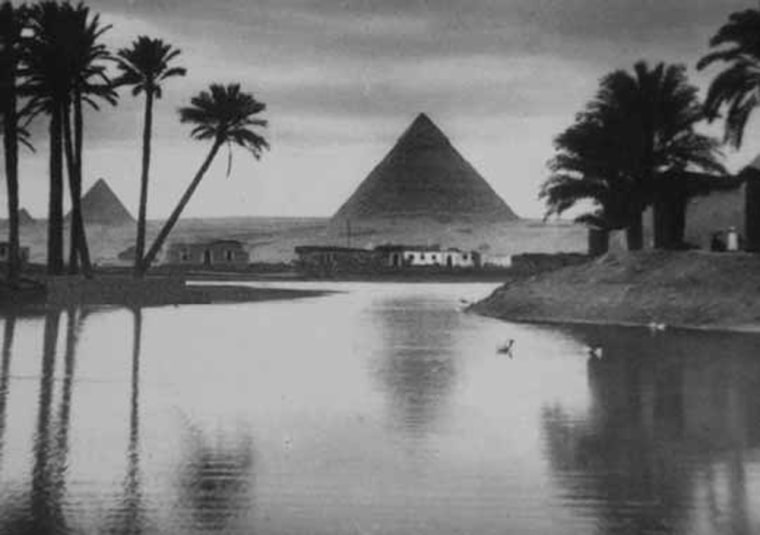Lord Carnarvon, the man who funded the discovery of the tomb of Tutankhamun and died five months later in mysterious circumstances before he could actually see the mummy's face, was a superstitious man who wore the same lucky bow tie all his life.
Such anecdotes are part of a unique exhibition at Highclere Castle, home of the Carnarvon family since the architect of London's Houses of Parliament built it in the 1840s.
Rising in the Berkshire countryside south of Newbury, England, the castle kept many secrets on its own. For more than 60 years, its walls concealed an important chapter of the King Tut search: a cache of Egyptian antiquities, excavated by George Herbert, 5th Earl of Carnarvon and his colleague and employee, Howard Carter in the years leading up to the discovery of the treasure-filled tomb.
"My grandfather was superstitious and did not want to talk about Egypt, so he took the Egyptian collection out of sight. It remained hidden away in a cupboard between two rooms down below the cellars for some 65 years. We found it after his death in 1987," George, the current earl — the eighth — told Discovery News.
The Highclere cache is just a tiny part of a magnificent collection which Almina, Lord Carnarvon's wife and the illegitimate daughter of Alfred de Rothschild of the famous banking family, sold to the Metropolitan Museum in New York in 1926.
The long-hidden collection is now presented in its full glory in the cellars of the castle, along with hundreds of unpublished photographs taken by Lord Carnarvon between 1907 and 1914. They were discovered two years ago in the family archives by Fiona, the Eighth Countess of Carnarvon.
"These pictures reveal the enormous scale of excavations that Lord Carnarvon and Carter carried in the decade before their most sensational finding. They tell the story of two amazing men, who have never been fully recognized in England for the discovery they have made," the Countess of Carnarvon told Discovery News.
The author of "Carnarvon & Carter," the Countess was researching a biography of the fifth Earl, her husband's great grandfather — oddly, none exists — when she discovered photos, letters, notes and drawing left by Lord Carnarvon and Carter.
The photographs show Carnarvon and Carter carrying baskets, bringing objects out of the tombs, directing the operations while wearing three-piece suits under the scorching sun.
Carnarvon and Carter are shown in shots at the cobra-infested Tel el Balamun site in the Delta, at excavations along the cliff edge and desert edges in the Birabi and around Deir El Bahri at Queen Hathepsut's temple.
"The old photographs, documents and items of memorabilia on display at Highclere convey an authentic 'feel' of the time and give a clear insight into what it was like to excavate in Egypt in the early 20th century," John Taylor, assistant keeper at the British Museum's department of Ancient Egypt and Sudan, told Discovery News.
Among the antiquities on display, are a splendid 3,500-year-old painted coffin of a woman named Irtyru, from Deir el-Bahri, a calcite shabti showing the head of Amenhotep III, silver bracelets from the Delta, faience bowls, a 5,000-year-old calcite dish used in priestly offerings, coffin faces carved in wood and alabaster vessels found at the entrance to the tomb of King Merneptah, the son of Ramesses II.
They may not be exactly the "wonderful things" Carter saw when he discovered King Tut's tomb in 1922, but they are important items as most of them are the only known group excavated from the tomb of Amenhotep III, most likely Tutankhamun's grandfather.
The end of the exhibition also represents the end of the story for Lord Carnarvon: on display the razor which he used in 1923. He cut a mosquito bite while shaving and the wound turned septic. He died of pneumonia brought on by blood poisoning on April 5, 1923, in the "hour of his triumph," as Carter wrote.
His death was marked by all lights going out in Cairo and his dog, Susie, dying at Highclere at the exact time of her master's death in Cairo. They are both buried on a hill overlooking Highclere Castle.
"This of course helped to build the myth of King Tut's curse. In the end, I find it amazing that Tutankhamun probably died of septicemia from a fractured leg, and 3,000 years later Carnarvon also died of septicemia," Fiona Carnarvon said.
The exhibition is open at Highclere Castle until Sept. 3.
